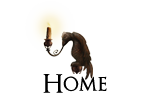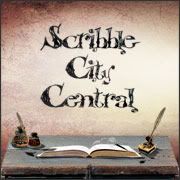Since my lovely scheduled guest author is unfortunately unable to type at the moment (get better soon, Michelle), Scribble City Central's thirty-sixth Fantabulous Fridays A-Z comes from me instead. I hope you won't be too disappointed.
Hallowe'en fell this week, time of ghosts, witches, fake spiderwebs, a myriad carved pumpkins - and the ubiquitious wholesale blackmail of householders which is trick-or-treat. Its origins, however, lie far back - far farther than the Christian Feast of All Hallows, which All Hallows Eve precedes, and after which Hallowe'en is named.
By rights, in this ancient land of Britain it should be called Samhain - pronounced Sow-win - (or in Wales, Nos Calan Gaeaf), as it was the pagan feast which marked the beginning of winter, and is one of the two great 'doorways' of the Celtic year when the veil between the worlds is at its thinnest and the gods and spirits are listening. What better time, then, to introduce you to a bunch of supernatural and spooky faerie spirits?
S for Slaugh
The Slaugh or Sluagh (pronounced Sloo-Ah) are known in both Ireland and Scotland as an unruly rabble of evil spirits who fly, like flocks of birds, on the wind's wings. Sometimes known as the Host of the Unforgiven Dead or the 'fairy wind', they are the souls of unsanctified and unshriven sinners who have crossed over into Faerie and become lost forever. Tradition has it that they always ride in from the West, looking for other mortal souls to steal and enslave, and it is best to keep the windows of a dying person's room closed on that side, so that they may be safe. The Slaugh were also rumoured to be able to carry off freshly dead bodies for their own nefarious purposes - which is why the funeral bier on which the corpse had rested used to be ritually smashed or burned in parts of Scotland and Ireland. They also took great pleasure in harming humans and in kidnapping those poor bodies, such as beggars and orphaned children, who would not be missed.
At Samhain, one legend says, the souls of all the dead who had died in the previous year were escorted to the gates of Heaven by a cavalcade of fairies, including the Slaugh. Naturally, since fairies have no souls themselves, they couldn't enter, which made them all the more spiteful and dangerous towards humans at this time. The Slaugh are also associated with the Wild Hunt - which rides with Herne the Hunter on Twelfth Night, scaring birds and beasts and chasing evil to the ends of the earth - depicted so brilliantly in Susan Cooper's Dark is Rising quintet.
Ever since I first came across them I've somehow associated the Slaugh with my childhood version of Christina Rossetti's Goblin Market. To me, this is a little how they'd look, except with a far more sinister and evil intent -:
There have been many representations of different aspects of the Slaugh in YA novels recently - certainly they feature in Melissa Marr's Wicked Lovely series and Holly Black's Modern Faerie Tales in a slightly different guise. The place where they appear entirely as themselves, though, is in Laurell K. Hamilton's Meredith Gentry series. Whether you like those books or not, Hamilton has, I think got closest of anyone to the essence of who the Slaugh are and what they represent. To me they are the feral underbelly of ruthless winter, the place where darkness lives. The Slaugh are, perhaps, the faerie embodiment of Jung's shadow, of Freud's Id - they represent the amoral, atavistic side which lies buried deep within each human psyche. Funnily enough, it's also the place where creativity lives - the place of both dreams and nightmares. Hold that thought, you writers of horror and the macabre, those (like me) who positively revel in bringing one or more of your characters to a bloodily satisfying end. A tiny bit of the Slaugh (or something very like it) lives on in all our imaginations.
Next week: Katherine Langrish delves deep into the lore of T for Trolls. See you then!
...Flying, running, leaping,I imagine them as wizened and bony, with tattered yellowish skin covering a travesty of the human form. They have batlike wings which fold around them in a sort of leathery cloak when not in flight, and their hands and feet have turned into bony, bird-like claws. Their thin hair hangs in dark greasy elflocks around haggard faces which snarl and sneer through a mouthful of broken teeth filed to sharp points. Since they can no longer pass as human, they lurk in the shadows of the night sky, on silent streets at midnight, in empty houses with broken windows. They are the creak of the stair at midnight, the sadness in the air at dusk, the weeping of the ragged soul. Other poets and writers have tried to sanitise them - made them into the grand and dignified Faery Rade of the Seelie Court, clad in samite and gold, riding the white and black horses which gallop as well on air as on land, but I see them entirely as growing from the deep roots of the anarchic, chaotic Unseelie court where hobgoblins and other scary beasties lurk among the thorn bushes.
Puffing and blowing,
Chuckling, clapping, crowing,
Clucking and gobbling,
Mopping and mowing,
Full of airs and graces,
Pulling wry faces,
Demure grimaces,
Cat-like and rat-like,
Ratel and wombat-like,
Snail-paced in a hurry,
Parrot-voiced and whistler,
Helter-skelter, hurry-skurry,
Chattering like magpies,
Fluttering like pigeons,
Gliding like fishes.... from Christina Rossetti's 'Goblin Market'
There have been many representations of different aspects of the Slaugh in YA novels recently - certainly they feature in Melissa Marr's Wicked Lovely series and Holly Black's Modern Faerie Tales in a slightly different guise. The place where they appear entirely as themselves, though, is in Laurell K. Hamilton's Meredith Gentry series. Whether you like those books or not, Hamilton has, I think got closest of anyone to the essence of who the Slaugh are and what they represent. To me they are the feral underbelly of ruthless winter, the place where darkness lives. The Slaugh are, perhaps, the faerie embodiment of Jung's shadow, of Freud's Id - they represent the amoral, atavistic side which lies buried deep within each human psyche. Funnily enough, it's also the place where creativity lives - the place of both dreams and nightmares. Hold that thought, you writers of horror and the macabre, those (like me) who positively revel in bringing one or more of your characters to a bloodily satisfying end. A tiny bit of the Slaugh (or something very like it) lives on in all our imaginations.
Next week: Katherine Langrish delves deep into the lore of T for Trolls. See you then!





















1 comment:
No disappointment, Lucy! A beautifully written, fascinating piece. But I look forward to Michelle's, and will be back for Katherine's trolls.
I'm interested that the Slaugh were identified with the Wild Hunt and said to lead the dead to the Underworld.
Odin led the Wild Hunt, and the Romans identied Wodan/Odin with their own Mercury, whose most important function was to guide the dead to the Underworld. So I guess that, in Pagan belief, Odin did the same.
So did Christianity reverse the meaning of the Wild Hunt? Preached that Odin was hunting down damned souls, instead of guiding them to the next world?
But your 'feral winter' interpretation appeals to me as well.7
Post a Comment